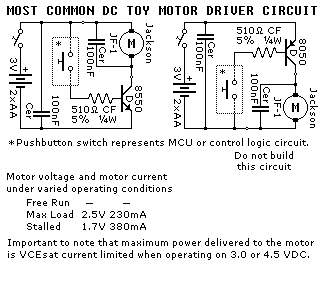Toy Motor Driver Circuit
HOMESmall DC motors in toys are usually driven very sloppily.
This is an actual reverse engineered circuit diagram of the one transistor circuit most commonly used to drive Permanent Magnet DC motors in childrens' toys. This type of circuit almost always uses the 625mW version of the ubiquitous 8050 or 8550 transistor. It is vital to note that there are two different varieties of each of these two transistors, and although they are often stamped with the same part number, they are not interchangeable because one is a 625mW part with a higher VCEsat, while the other is a 1W part with a lower VCEsat. This is very confusing because you often have to run tests on these transistors to tell them apart! The important feature to note about this circuit, is that the maximum power delivered to the motor is normally designed to be limited by the VCEsat of the transistor, and almost never by the HFE or base current. This works beutifully for childrens toys which are designed around a 3 volt or 4.5 volt power supply, because whenever the child stalls the motor, this natural current limiting prevents burnout of the transistor and also preserves the battery life. The critical importance of the prior statement can not be overstated. Please not also that the ceramic transient suppression capacitor is always soldered directly across the motor terminals, and note that the filter capacitor across the power supply is just as often a small electrolytic instead of a ceramic disk, depending on the motor transient supression requirements of the control circuitry.

Picture of a typical motor and the famous 8050 transistor:

Safety, accuracy and completeness of information provided herein is not guaranteed,
so be inspired by it but do not use it as a basis for experimentation or other actions.
 |
TOP | ©™ |
|
|
Version 20231217